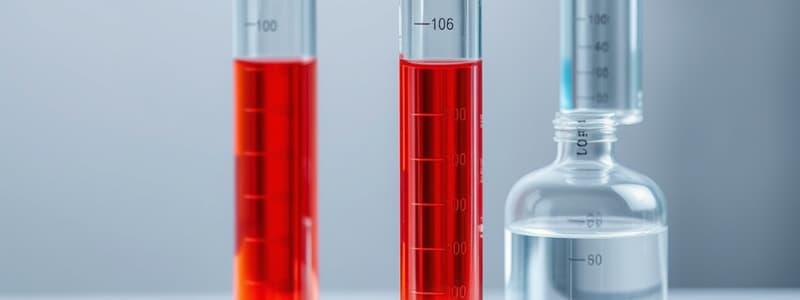Podcast
Questions and Answers
What are the two components of a binary solution?
What are the two components of a binary solution?
Solvent and solute
Which type of solution consists of a gas as both the solute and solvent?
Which type of solution consists of a gas as both the solute and solvent?
- Liquid Solution
- Gaseous Solution (correct)
- Solid Solution
- None of the above
Colligative properties of solutions are only dependent on the type of solute present.
Colligative properties of solutions are only dependent on the type of solute present.
False (B)
What is the definition of a homogeneous mixture?
What is the definition of a homogeneous mixture?
Which law explains the relationship between the solubility of gas and its partial pressure?
Which law explains the relationship between the solubility of gas and its partial pressure?
What does ppm stand for in the context of solution concentration?
What does ppm stand for in the context of solution concentration?
A solution is formed when a __________ is dissolved in a __________.
A solution is formed when a __________ is dissolved in a __________.
What is an example of a solid solution?
What is an example of a solid solution?
What happens if high concentrations of fluoride ions are present in water?
What happens if high concentrations of fluoride ions are present in water?
Flashcards are hidden until you start studying
Study Notes
Objectives of the Unit
- Understand the formation of various types of solutions in the body.
- Learn to express solution concentration using different units.
- State and explain Henry’s law and Raoult’s law.
- Distinguish between ideal and non-ideal solutions.
- Explain how real solutions deviate from Raoult’s law.
- Describe colligative properties of solutions and their correlation with solute molar masses.
- Understand abnormal colligative properties exhibited by certain solutes.
Importance of Solutions
- Body processes predominantly occur in liquid solutions, not pure substances.
- Real-life mixtures consist of two or more pure substances, affecting their physical and chemical properties.
- Examples highlight how properties differ among mixtures: brass, German silver, and bronze.
Types of Solutions
- Solutions are homogeneous mixtures with uniform composition and properties.
- The component present in the largest amount is termed the solvent; others are solutes.
- Focus primarily on binary solutions, consisting of two components, which may be solid, liquid, or gas.
Classification of Solutions
Gaseous Solutions
- Gas as solute and gas as solvent: mixture of oxygen and nitrogen.
- Liquid as solute and gas as solvent: chloroform mixed with nitrogen.
- Solid as solute and gas as solvent: camphor dissolved in nitrogen.
Liquid Solutions
- Gas as solute and liquid as solvent: oxygen in water.
- Liquid as solute and liquid as solvent: ethanol in water.
- Solid as solute and liquid as solvent: glucose in water.
Solid Solutions
- Gas as solute and solid as solvent: hydrogen in palladium.
- Liquid as solute and solid as solvent: amalgam of mercury and sodium.
- Solid as solute and solid as solvent: copper in gold.
Expressing Concentration
- Concentration can be described qualitatively (dilute or concentrated) but is often confusing in practical scenarios.
- Emphasis on the need for quantitative descriptions to realize exact solution concentrations.
Studying That Suits You
Use AI to generate personalized quizzes and flashcards to suit your learning preferences.




